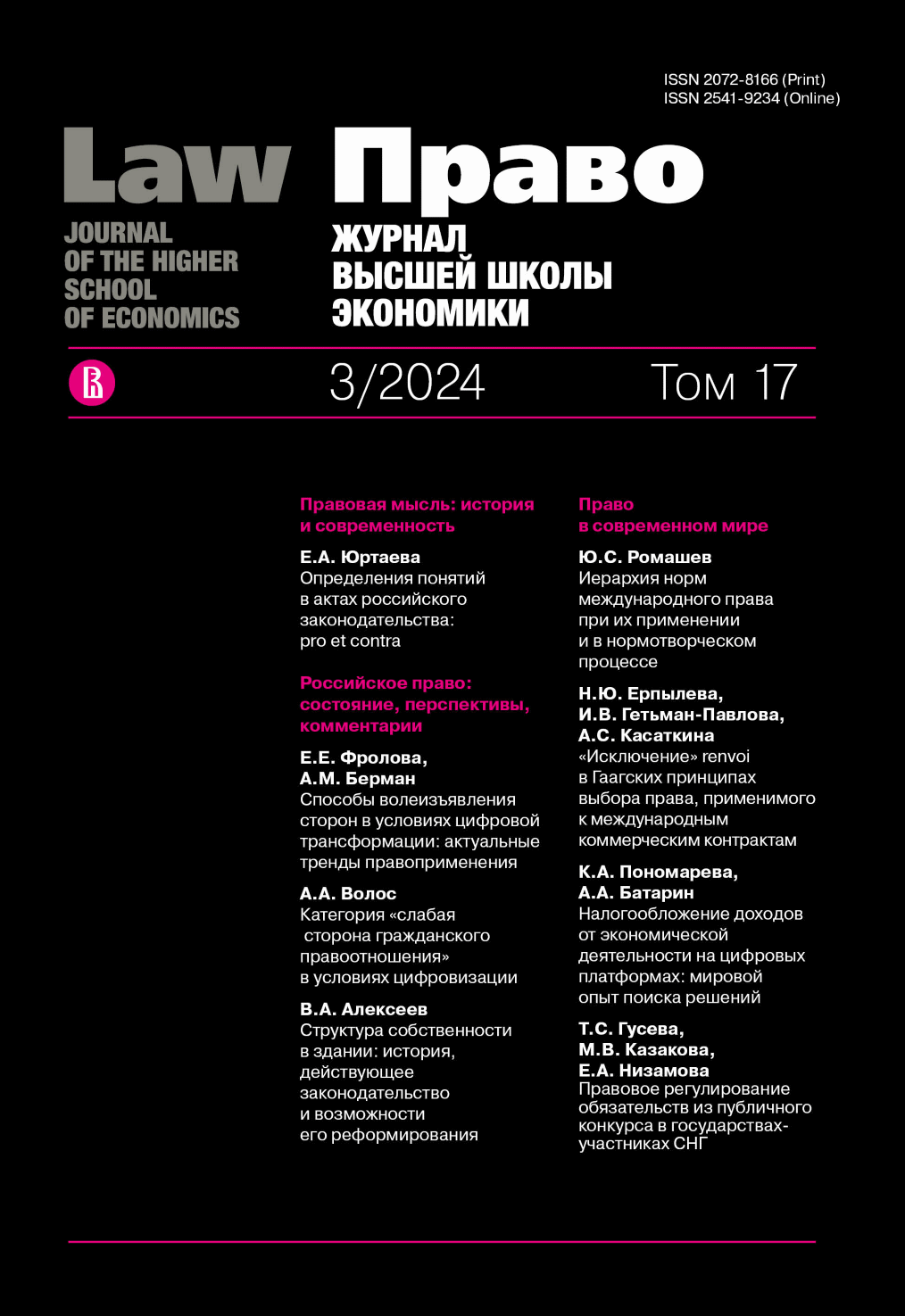Иерархия норм международного права при их применении и в нормотворческом процессе
Аннотация
В практике государств важное значение имеет правильное применение норм международного права, от которого напрямую зависит действенность правового регулирования. Довольно часто при этом не в полной мере учитываются важность тех или иных норм, их иерархия в международно-правовой системе, методология данного вопроса. Практическая значимость оценки иерархии норм заключается в ответе на вопрос — какая норма в данной ситуации применима или должна быть применима? В рамках международного нормотворчества необходимость учета иерархии норм состоит в предотвращении появления будущих правовых коллизий. В настоящей работе с позиции диалектического подхода, использования общенаучных и специальных юридических методов исследования рассмотрены основные подходы к учету иерархии норм международного права при их применении и нормотворческом процессе. В работе показаны особенности, присущие различным видам норм международного права, которые могут быть положены в основу оценки. Особое внимание уделено оценке иерархии норм при возникновении коллизий между ними, исследованы причины их появления. Показаны методы разрешения коллизий, используемый при этом правовой инструментарий. Обращено внимание на важность оценки иерархии норм международного права во взаимосвязи с оценкой иерархии однородных и разнородных источников, содержащих такие нормы. В работе содержится алгоритм учета иерархии норм международного права при их применении. Рассмотрены случаи, когда разрешить коллизии невозможно и какие основные действия нужно предпринимать в таких ситуациях. Раскрыты пути противодействия появлению потенциальных коллизий норм международного права. Показана трудность ситуации, связанная с фрагментацией международного права и возрастанием количества норм, содержащих коллизии, их разнообразием, что существенно осложняет правоприменение, выбор оптимального решения. Указано, что решение такой объемной и многоплановой проблемы требует высококачественной аналитической работы с привлечением современных технологий, в том числе связанных с искусственным интеллектом.
Литература
Cassese A. (2005) International Law. Oxford: University Press, 558 p.
Chernichenko S.V. (2012) Interconnection of imperative norms of international law (jus cogens) and obligations erga omnes. Moskovskiy journal mezhdunarodnogo prava, no. 3, pp. 3–17 (in Russ.)
Chernichenko S.V. (2014) Contours of international law. Moscow: Nauchnaya kniga, 592 p. (in Russ.)
Chernichenko S.V. (1999) Theory of International Law. Moscow: NIMP, 336 p. (in Russ.)
Dupuy P.-M. (2008) Droit International Public. Paris: Dalloz. 850 p.
Getman-Pavlova I.V., Postnikova E.V. (2019) International Law. Moscow: Yurait, 560 p. (in Russ.)
Golubtsov V.G. (2022) Temporal Conflict Norms as Legal Means of Overcoming Temporary Contradictions between Legal Norms. Rossiyskiy yuridicheskiy journal=Russian Law Journal, no. 1, pp. 20–33 (in Russ.) DOI: https://doi.org/10.34076/20713797_2022_1_20
Grib V.V. et al. (2021) Theory of state and law. Moscow: Jurist, 1008 p. (in Russ.)
Kapustin A.Ya. et al. (2022) Modern concept of interpretation of international treaties. Moscow: Norma, 432 p. (in Russ.) DOI: https://doi.org/10.12737/1839409
Kelsen H. (1961) General Theory of Law and State. New York: Russell and Russell, 516 p.
Kolodkin R.A. (2005) Fragmentation of International Law. Moskovskiy journal mezhdunarodnogo prava=Moscow Journal of International Law, no. 2, pp. 38–61 (in Russ.)
Lecturer G. (2022) The conflict of international rules devices. Journal of Law and Administrative Sciences, no. 18, pp. 25–30.
Malanczuk P. (1997) Akehurst’s Modern Introduction to International Law. London: Routledge, 449 p.
Michaels R., Pauwelyn J. (2012) Conflict of Norms or Conflict of Laws? Different Techniques in the Fragmentation of Public International Law. Duke Journal of Comparative & International Law, vol. 22, no. 3, pp. 349–376.
Petrov A.A. (2017) Coincidence of content and temporal collisions of legal norms. Journal rossiiskogo prava=Journal of Russian Law, no. 8, pp. 28–41 (in Russ.) DOI: https://doi.org/10.12737/article_597714e8091556.13559373
Pauwelyn J. (2003) Conflict of Norms in Public International Law: How WTO Law Relates to other Rules of International Law. New York: Cambridge University Press, 525 p. DOI: https://doi.org/10.1017/CBO9780511494550
Prost M. (2017) Hierarchy and the Sources of International Law: A Critical Perspective. Houston Journal of International Law, vol. 39, no. 2, pp. 285–330.
Ramanujan A. (2009) Conflicts over «Conflict»: Preventing Fragmentation of International Law. Trade, Law and Development, vol. 1, no. 1, pp. 171–191.
Shelton D. (2006) Normative Hierarchy in International Law. American Journal of International Law, vol. 100, no. 2, pp. 291–323. DOI: https://doi.org/10.1017/S0002930000016675
Shestakov L.N. (1981) Imperative Norms in the System of International Law. Moscow: University, 120 p. (in Russ.)
Vidmar J. (2012) Norm Conflicts and Hierarchy in International Law: Towards a Vertical International Legal System? In: Hierarchy in International Law: The Place of Human Rights. Oxford: University Press, pp. 1–38. DOI: https://doi.org/10.1093/acprof:oso/9780199647071.003.0002
Vranes E. (2006) The Definition of ‘Norm Conflict’ in International Law and Legal Theory. The European Journal of International Law, vol. 17, no. 2, pp. 395–418. DOI: https://doi.org/10.1093/ejil/chl002
Copyright (c) 2024 Ромашев Ю.

Это произведение доступно по лицензии Creative Commons «Attribution-ShareAlike» («Атрибуция — На тех же условиях») 4.0 Всемирная.


















